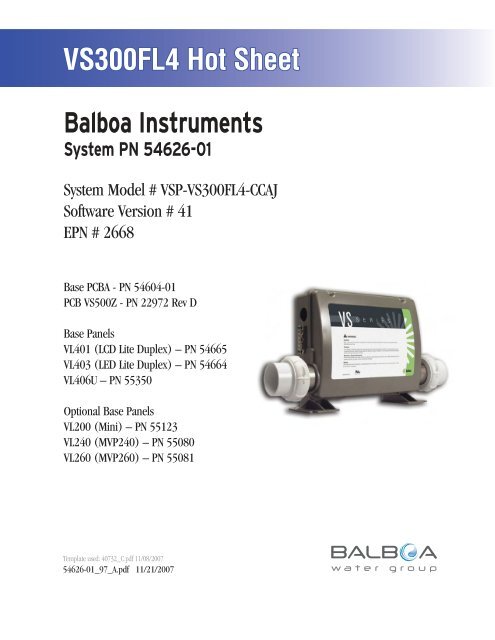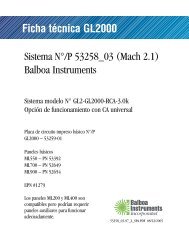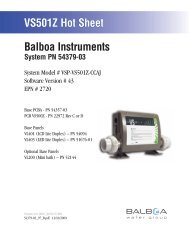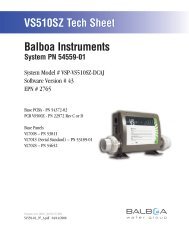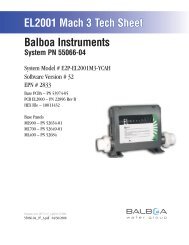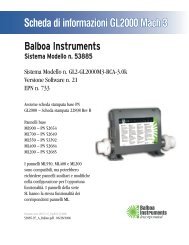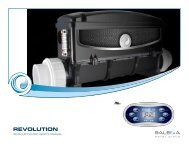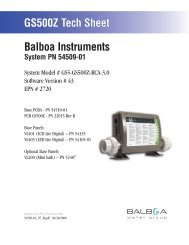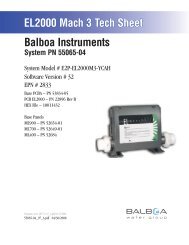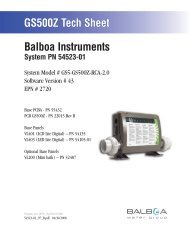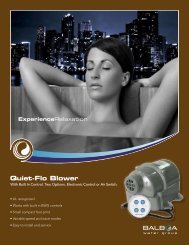54626-01, VSP-VS300FL4-CCAJ - Balboa Direct
54626-01, VSP-VS300FL4-CCAJ - Balboa Direct
54626-01, VSP-VS300FL4-CCAJ - Balboa Direct
Create successful ePaper yourself
Turn your PDF publications into a flip-book with our unique Google optimized e-Paper software.
<strong>VS300FL4</strong> Hot Sheet<br />
<br />
<br />
System Model # <strong>VSP</strong>-<strong>VS300FL4</strong>-<strong>CCAJ</strong><br />
Software Version # 41<br />
EPN # 2668<br />
Base PCBA - PN 54604-<strong>01</strong><br />
PCB VS500Z - PN 22972 Rev D<br />
Base Panels<br />
VL4<strong>01</strong> (LCD Lite Duplex) – PN 54665<br />
VL403 (LED Lite Duplex) – PN 54664<br />
VL406U – PN 55350<br />
Optional Base Panels<br />
VL200 (Mini) – PN 55123<br />
VL240 (MVP240) – PN 55080<br />
VL260 (MVP260) – PN 55081<br />
Template used: 40732_C.pdf 11/08/2007<br />
<strong>54626</strong>-<strong>01</strong>_97_A.pdf 11/21/2007<br />
Page 1<br />
<strong>54626</strong>-<strong>01</strong>_97_A
System Revision History<br />
System PN EPN Date Requested By Changes Made<br />
<strong>54626</strong> 1710 02.14.2007 <strong>Balboa</strong> New system<br />
<strong>54626</strong>-<strong>01</strong> 2668 11.21.2007 <strong>Balboa</strong> Software update to v41, model now <strong>VS300FL4</strong><br />
Page 2<br />
<strong>54626</strong>-<strong>01</strong>_97_A
Basic System Features and Functions<br />
Power Requirements<br />
<br />
<br />
System Outputs<br />
Setup 1 (As Manufactured)<br />
<br />
<br />
<br />
<br />
<br />
Optional Panels<br />
<br />
<br />
<br />
Additional Options<br />
<br />
<br />
<br />
<br />
Page 3<br />
<strong>54626</strong>-<strong>01</strong>_97_A
C<br />
G<br />
Basic System Features and Functions<br />
Any time you change a DIP Switch, other than A1, you must reset Persistent<br />
Memory for your new DIP Switch Settings changes to take effect. If you do<br />
not reset Persistent Memory, your system may function improperly.<br />
To reset Persistent Memory:<br />
Power down by disconnecting power source from spa.<br />
Put a jumper across J43, covering both pins. (See illustration below)<br />
Power up by connecting power source to spa.<br />
Wait until “ ” is displayed on your panel.<br />
Power down again.<br />
Remove jumper from J43 (May also move to cover 1 pin only)<br />
Power up again.<br />
About Persistent Memory and Time of Day Retention:<br />
This system uses memory that doesn’t require a battery to store a variety of<br />
settings. What we refer to as Persistent Memory stores the filter settings,<br />
the set temperature, and the heat mode.<br />
Persistent Memory is not used for Time of Day. Only models with a<br />
Serial Deluxe panel installed (VS5xxDZ and GS5xxDZ) can display the<br />
time. However, during power loss to the spa, the system will lose the<br />
correct time, and reset to 12:00 PM when power is restored.<br />
Power Up Display Sequence<br />
Upon power up, you should see the following on the display:<br />
Three numbers in a row, which are the SSID (the System Software<br />
ID). The third display of these numbers is the Software Version,<br />
which should match the version of your system. For example, if these<br />
three numbers are , that is a VS511SZ at version 38.<br />
Displayed next is: “ ” (indicating the system is configured for<br />
a heater between 3 and 6 kW) or “ ” (indicating the system is<br />
configured for a heater effectively* between 1 and 3 kW).<br />
“ ” should appear for all VS models running at 240VAC.<br />
“ ” should appear for all VS models running at 120VAC, as well<br />
as all GS models. (*A heater which is rated at 4 kW at 240VAC will<br />
function as a 1 kW heater at 120VAC.)<br />
“ ” will appear to signal the start of Priming Mode.<br />
At this point, the power up sequence is complete. Refer to the Reference<br />
Card for the VS or GS System model of your spa for information about how<br />
the spa operates from this point on, including how to adjust the Time of<br />
Day if using a Serial Deluxe style panel.<br />
J43<br />
E.GND<br />
K6<br />
G C<br />
F4 FUSE .3A 250V<br />
J23<br />
K1<br />
W1<br />
SWITCHBANK<br />
T1A<br />
K3<br />
K2<br />
F2<br />
W4<br />
E.GND<br />
J50<br />
G C<br />
J6<br />
G C<br />
SWITCHBANK A<br />
F7<br />
J17/26<br />
S1 TST<br />
FUSE 20A 250V<br />
W7<br />
K8<br />
K9<br />
J43<br />
J2<br />
J1<br />
J46<br />
J60 J22<br />
J6 J7 J8<br />
S1 TST<br />
EXT.<br />
AUX. F<br />
RLY<br />
SEN. A SEN. B<br />
J47<br />
G C<br />
W2<br />
W3<br />
J1A<br />
J2A<br />
J29<br />
G C<br />
K5<br />
1 2 3<br />
U4 J12<br />
J20<br />
F1<br />
J10<br />
FUSE 3A 250V<br />
J18<br />
J13<br />
BALBOA INSTRUMENTS, INC. 2-SPD<br />
J44 VS500Z<br />
EXT RLY<br />
P/N 22972 REV D<br />
VAC<br />
MADE IN U.S.A<br />
COPYRIGHT 2005<br />
J43 on VS5xxZ and VS300 Series Main Board Shown.<br />
J43 on GS5xxZ Series is located in approximately the same position.<br />
J26<br />
J90<br />
J50<br />
LINE<br />
BLK AC<br />
W1<br />
K4<br />
K1<br />
VS100<br />
P/N 22964_B MADE IN U.S.A.<br />
© 2006<br />
PUMP<br />
T0.25A 250V<br />
<strong>Balboa</strong><br />
J58<br />
G C<br />
J23<br />
F2<br />
HEATER<br />
OZONE<br />
J29<br />
G C<br />
WHT AC<br />
K3<br />
J9<br />
K2<br />
K5<br />
SWITCHBANK A<br />
NEUTRAL<br />
J57<br />
TST RST<br />
J6 J43<br />
F4<br />
S1<br />
SWITCHBANK A<br />
TST RST<br />
J6 J43<br />
J43 on VS100/GS100 Series Main Board Shown.<br />
F5, F3A 250V<br />
J13 J12<br />
J7<br />
SEN. A<br />
J8<br />
SEN. B<br />
J18<br />
U4<br />
J20<br />
G C<br />
J1<br />
Page 4<br />
<strong>54626</strong>-<strong>01</strong>_97_A
Wiring Configuration and DIP Settings<br />
Setup 1 (As Manufactured)<br />
<br />
<br />
<br />
<br />
<br />
<br />
<br />
Black jumper required.<br />
Do not remove.<br />
Ozone must be same voltage as Pump 1.<br />
Ozone runs with Pump 1 low-speed.<br />
DIP A10 must<br />
be ON and<br />
jumper added<br />
for 120V systems.<br />
Remove for<br />
240V Systems.<br />
K4<br />
CLASS G FUSE 30A<br />
TORQUE<br />
RANGE<br />
FOR TB1:<br />
27-30 IN. LBS.<br />
F5<br />
WHT AC<br />
J11 J15 J25 J63<br />
NEUTRAL<br />
WHITE<br />
HOT<br />
BLACK<br />
HOT<br />
RED<br />
TB1<br />
K6<br />
F4 FUSE .3A 250V<br />
J23<br />
K1<br />
J73<br />
2-Spd P1<br />
G C<br />
K3<br />
K2<br />
W1<br />
T1<br />
W10<br />
FUSE 3A 250V<br />
J1<br />
W2<br />
U4<br />
J29<br />
Ozone<br />
G C<br />
K5<br />
J20<br />
12V<br />
Light<br />
G C<br />
F1<br />
FUSE 3A 250V<br />
J18<br />
J32 J33<br />
J43<br />
RED AC<br />
F2<br />
<strong>Balboa</strong><br />
HTR2<br />
HTR1<br />
E.GND<br />
SWITCHBANK A<br />
J6 J7 J8<br />
S1 TST<br />
SEN. A SEN. B<br />
BALBOA INSTRUMENTS, INC.<br />
VS500Z<br />
P/N 22972 REV D<br />
MADE IN U.S.A<br />
COPYRIGHT 2005<br />
Heater rated @ 240V<br />
4.0 kW<br />
(Approx. 1kW @ 120V)<br />
WARNING: Main Power to system should be turned OFF BEFORE adjusting DIP switches.<br />
WARNING: Persistent Memory (J43) must be RESET to allow new DIP switch settings to take effect. (See Persistent Memory page)<br />
SSID #<br />
100<br />
59<br />
41<br />
A1, Test Mode OFF<br />
A2, Un, P1, LT, P1, TD, TE, TU LT A7, Mode changes allowed<br />
A4, N/A (must be OFF) A9, P1-low timeout, Table 1<br />
A5, P1-high timeout, Table 1 A10, High Amp mode<br />
Panel Button Assignments<br />
Panel Button Positions<br />
1=Pump 1=Unused1<br />
2=Light 2=Pump 1<br />
3=Temp Down<br />
4=Temp 4=Light Up<br />
1 2 3 4<br />
1<br />
4 2<br />
Page 5<br />
J43<br />
Memory<br />
Reset<br />
3<br />
Wiring Color Key<br />
120 Volt Connections<br />
240 Volt Connections<br />
Black AC Jumpers<br />
12 Volt Connections<br />
Relay Control Wires<br />
Board Connector Key<br />
1 Typically Line voltage<br />
2 Typically Line voltage for 2-speed pumps<br />
3 Neutral (Common)<br />
4 Ground<br />
Note flat sides in connector<br />
<strong>54626</strong>-<strong>01</strong>_97_A
DIP Switches and Jumpers Definitions<br />
SSID 100 59 41<br />
Base Model VS300F<br />
DIP Switch Key<br />
A1 Test Mode (normally OFF)<br />
A2 “ON” position: Button layout will be: Pump 1, Light, Temp Down, Temp Up *<br />
“OFF” position: Button layout will be: Unused, Pump 1, Temp, Light<br />
A3 “ON” position: use Mini Panel *<br />
“OFF” position: use Lite Duplex or Digital Duplex panel<br />
A4 N/A (must be OFF)<br />
A5 Pump 1 high-speed timeout, see Table 1<br />
A6 “ON” position: 50Hz operation<br />
Table 1 Pump 1 Timeouts<br />
“OFF” position: 60Hz operation<br />
A5 A9 Low-spd Hi-spd<br />
A7 “ON” position: Standard mode only<br />
OFF OFF 2 hours 15 min<br />
“OFF” position: Std/Ecn/Sleep mode changes allowed<br />
ON OFF 2 hours 30 min<br />
A8 “ON” position: temperature is displayed in degrees Celsius<br />
OFF ON 15 min 15 min<br />
“OFF” position: temperature is displayed in degrees Fahrenheit<br />
ON ON 30 min 30 min<br />
A9 Pump 1 low-speed timeout, see Table 1<br />
A10 “ON” position: heater is disabled while the high-speed pump is running (low amperage mode)<br />
“OFF” position: heater can run while the high-speed pump is running (high amperage mode)<br />
* Panels with button layout are not compatible when A2 or A3 is ON.<br />
Note: No blower or second pump available.<br />
Jumper Key<br />
J43 When jumper is placed on 2 pins during power-up, system will reset persistent memory.<br />
Leave on 1 pin only to enable persistent memory feature.<br />
WARNING:<br />
Setting DIP switches incorrectly may cause abnormal system behavior and/or damage to system components.<br />
Refer to Switchbank illustration on Wiring Configuration page for correct settings for this system.<br />
Contact <strong>Balboa</strong> if you require additional configuration pages added to this hot sheet.<br />
Panel Button Positions<br />
A3: OFF<br />
1 2 3 4<br />
1<br />
4 2<br />
3<br />
A3:ON<br />
1<br />
2 3 4<br />
A2: OFF<br />
Panel Button Assignments<br />
1=Unused<br />
2=Pump 1<br />
3=Temp<br />
4=Light<br />
A2:ON<br />
1=Pump 1<br />
2=Light<br />
3=Temp Down<br />
4=Temp Up<br />
Page 6<br />
<strong>54626</strong>-<strong>01</strong>_97_A
W<br />
W<br />
Ozone Connections<br />
Ozone voltage must be wired to same voltage as Pump 1.<br />
Ozone Connector Voltage: The VS300/VS300F circuit board is factory configured to deliver a preset voltage<br />
(120V or 240V) to the on-board ozone connector (J29). See the ratings table on the wiring diagram attached to<br />
the cover of the enclosure for the configured voltage. For 240V output W2 connects to Red AC and for 120V<br />
output W2 connects to White AC.<br />
The voltage to the ozone connector can be changed in the field if required. W2 just needs to be set for the<br />
required voltage. Reminder: Ozone voltage must be set to match Pump 1 voltage.<br />
<strong>Balboa</strong> Ozone Generator: If the board is set up to operate a 120V ozone generator, the connector on the ozone<br />
generator is likely to be configured correctly, but should be compared to the illustration below.<br />
If a 240V ozone generator is required, be sure the red wire in the ozone cord is positioned in the connector next<br />
to the green ground wire as described below.<br />
Note: A special tool is required to remove the pins from the connector body once they are snapped in place.<br />
Check with your <strong>Balboa</strong> Account Manager for information on purchasing a pin-removal tool.<br />
<strong>Balboa</strong> Ozone connector configuration for 120V 60Hz<br />
Line - Black conductor<br />
Use this slot for the leftover Red conductor<br />
Common - Install the White conductor here for 120V ozone<br />
Ground (Green) conductor<br />
B<br />
G<br />
<strong>Balboa</strong> Ozone connector configuration for 240V 60Hz<br />
Line - Black conductor<br />
Use this slot for the leftover White conductor<br />
Common - Install the Red conductor here for 240V ozone<br />
Ground (Green) conductor<br />
Flat sides of sockets as shown<br />
B<br />
G<br />
USE 3A 250V<br />
J29<br />
W2<br />
K5<br />
J20<br />
12V<br />
Light<br />
F1<br />
FUSE 3A 250V<br />
Line - Black conductor<br />
Use this slot for the leftover conductor<br />
Common - Red for 240V or White for 120V ozone (See W2 wire)<br />
Ground (Green) conductor<br />
W2 wire determines voltage<br />
J1<br />
J10<br />
Page 7<br />
<strong>54626</strong>-<strong>01</strong>_97_A
Duplex Panel Configurations<br />
Jets<br />
Warm<br />
Light<br />
Heat<br />
Cool<br />
DIP switch A3 must be OFF<br />
SETUP (AS MANUFACTURED)<br />
VL406U<br />
PN 55350 with Overlay PN 11947<br />
Connects to Main Board terminal J1<br />
Cannot convert to VL406T by changing overlay<br />
Jets Light Cool Warm<br />
Heat<br />
Jets Light Cool Warm<br />
Heat<br />
VL403 (Lite Digital)<br />
PN 54664 with Overlay PN 11884<br />
Connects to Main Panel terminal J1<br />
VL4<strong>01</strong> (Lite Digital)<br />
PN 54665 with Overlay PN 11885<br />
Connects to Main Panel terminal J1<br />
Jets<br />
Light<br />
Cool<br />
Warm<br />
DIP switch A3 must be ON<br />
OPTIONAL PANELS<br />
VL260 (MVP260)<br />
PN 55081 with Overlay PN 11746<br />
Connects to Main Panel terminal J1<br />
Jets<br />
Light<br />
Cool<br />
Warm<br />
Jets Light Cool Warm<br />
VL200 (Mini Panel)<br />
PN 55123 with Overlay PN 11852<br />
Connects to Main Panel terminal J1<br />
VL240 (MVP240)<br />
PN 55080 with Overlay PN 11745<br />
Connects to Main Panel terminal J1<br />
Page 8<br />
<strong>54626</strong>-<strong>01</strong>_97_A


